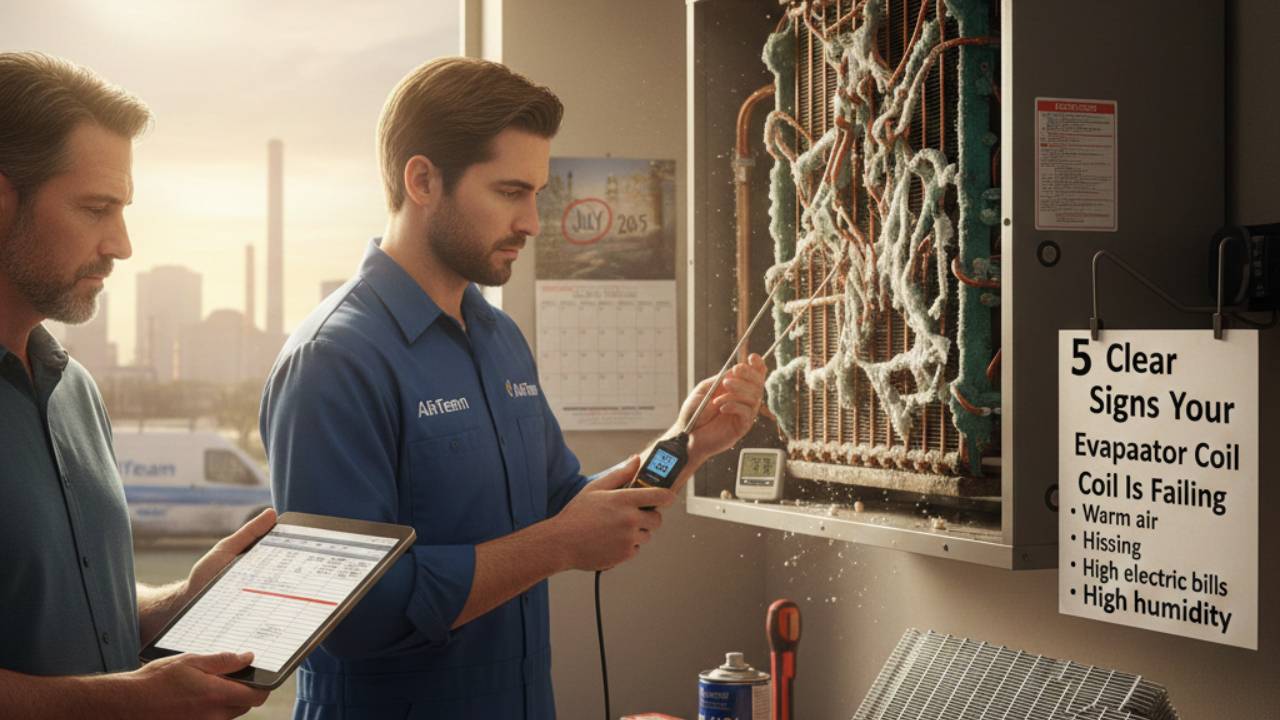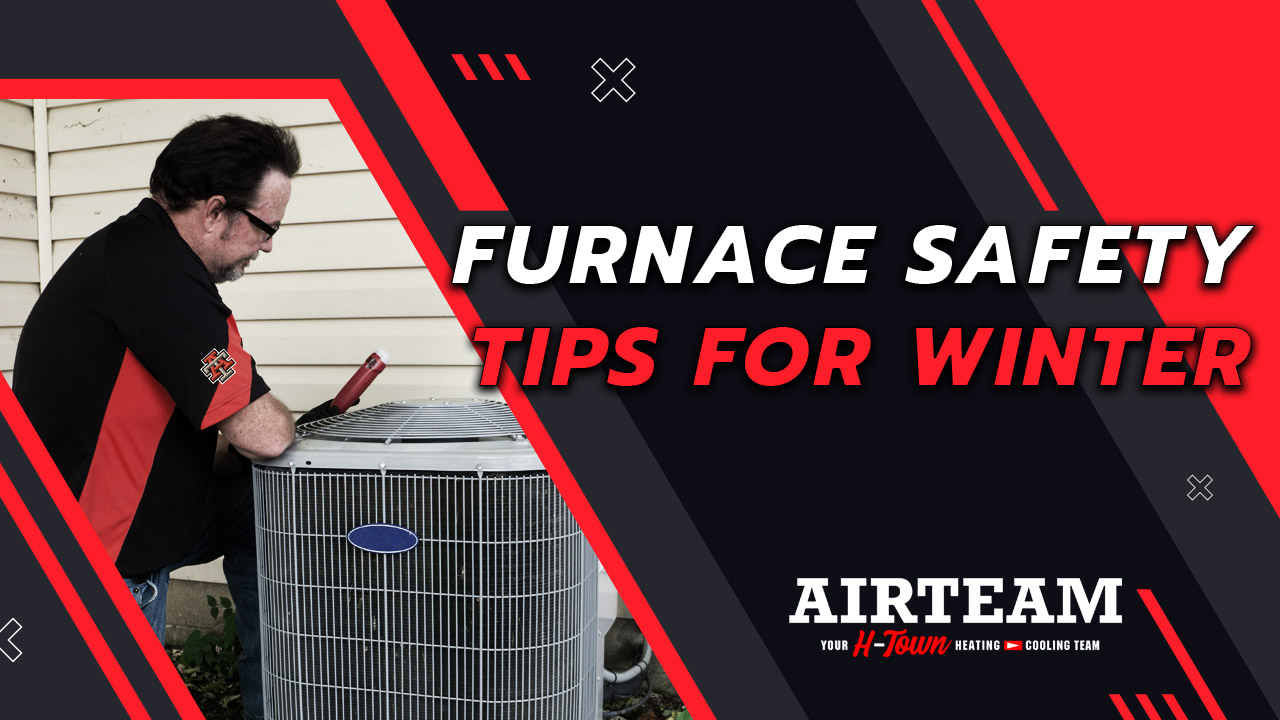As winter approaches in Houston and temperatures begin to dip, your furnace becomes the workhorse of your HVAC system, keeping you and your family warm and comfortable. But what happens when your furnace isn’t performing as it should?
Signs That Your Furnace Has A Problem
Knowing the warning signs of a furnace problem can help you catch issues early, avoiding costly repairs or even a complete system failure. AIRTEAM Heating & Cooling is here to help you spot potential problems and keep your heating system running smoothly all season long.
Unusual Noises Coming From The Furnace
One of the first signs that something might be wrong with your furnace is unusual noises. While some operational sounds are normal, loud or unexpected noises should never be ignored. Pay attention to sounds like:
- Banging or clunking: could indicate loose or broken parts inside your furnace.
- Squealing: Often caused by a loose or worn belt.
- Rattling: This may indicate loose ductwork or a failing motor.
- Humming or buzzing: Could point to electrical issues.
If you hear any of these noises, it’s time to call a professional for an inspection. Ignoring these sounds can lead to further damage and potentially higher repair costs
Weak or Inconsistent Airflow
When your furnace is running, the airflow from your vents should be strong and consistent. If you notice weak or uneven airflow, it could be a sign of:
- A clogged air filter
- Blocked or leaking ductwork
- A failing blower motor
Weak airflow not only makes it harder for your home to reach the desired temperature but also forces your furnace to work harder, which can lead to additional wear and tear. Replacing air filters regularly and scheduling routine duct cleaning can help maintain proper airflow.
The Furnace Is Constantly Running
Your furnace should cycle on and off to maintain the temperature set on your thermostat. If it seems like your furnace is running constantly or cycling on and off too frequently, it’s a sign that something isn’t right. Common causes include:
- A malfunctioning thermostat
- Dirty or clogged filters
- Improperly sized furnace for your home
A furnace that’s running too often not only wastes energy but can also lead to premature wear on components. Addressing this issue quickly can save you money on your energy bills and prevent future breakdowns.
Cold Spots in Your Home
Are some rooms in your house significantly colder than others, even when the furnace is running? Uneven heating is another indicator of a potential problem with your furnace. This could be caused by:
- Issues with your ductwork, such as leaks or blockages
- A failing blower fan
- An undersized or aging furnace
If you’re experiencing uneven heating, it’s best to have a professional evaluate your system. Addressing these issues can improve your comfort and help your furnace operate more efficiently.
Rising Energy Bills
If your energy bills suddenly spike without an increase in usage, it could be a sign that your furnace is struggling to operate efficiently. When components are dirty, worn, or malfunctioning, your system has to work harder to heat your home, which uses more energy. According to the U.S. Department of Energy, heating accounts for about 45% of the average homeowner’s energy bill, so inefficiencies can add up quickly.
Regular maintenance, such as replacing filters and cleaning components, can help your furnace run efficiently and keep your energy costs in check. If your bills continue to climb despite these efforts, it’s time to call in the professionals.
The Furnace Won’t Turn On
Few things are more frustrating on a cold winter day than a furnace that won’t turn on. If your furnace refuses to start, the issue could be:
- A tripped circuit breaker or blown fuse
- A malfunctioning thermostat
- Pilot light or ignition problems
- A completely failed system
While some of these issues may be resolved with a quick fix, others require professional attention. Don’t wait— addressing a furnace that won’t turn on is critical for restoring warmth to your home and preventing further damage to the system
The Pilot Light or Burner Flame Is Yellow
If your furnace has a pilot light or burner flame, it should be a steady blue color. A yellow or flickering flame can indicate a dangerous issue, such as incomplete combustion or carbon monoxide. This could be caused by:
- A dirty or clogged burner
- Poor ventilation
- A cracked heat exchanger
Carbon monoxide is a serious health hazard. If you notice a yellow flame or suspect a carbon monoxide leak, turn off your furnace immediately, ventilate your home, and call a professional to inspect your system. Make sure you also have working carbon monoxide detectors installed in your home for added safety.
Unusual Smells or Odors
Your furnace shouldn’t produce any strange smells during normal operation. If you notice any unusual odors, it’s important to address them right away. Common odors include:
- Burning dust: Normal when you first turn on your furnace for the season, but it should go away quickly.
- Burning rubber or metallic smell: Could indicate overheating or a mechanical issue.
- Rotten egg smell: A sign of a natural gas leak—leave your home immediately and call your gas provider.
If any smells persist or worsen, contact a professional to inspect your furnace and identify the cause.
Short Cycling
Short cycling occurs when your furnace turns on and off repeatedly without completing a full heating cycle. This can be caused by:
- An overheating system due to restricted airflow or dirty components
- A malfunctioning thermostat
- Improper furnace size
Short cycling not only prevents your home from being properly heated but also puts unnecessary strain on your system, leading to higher energy bills and a shorter lifespan. A professional inspection can pinpoint the cause and restore your furnace’s normal operation.
Your Furnace Is Old
Furnaces typically last between 15-20 years, depending on how well they’ve been maintained. If your system is approaching or exceeding this age and showing signs of inefficiency or frequent breakdowns, it may be time to consider a replacement. Newer systems are much more energy-efficient and can save you money in the long run. If you’re unsure whether to repair or replace your furnace, our team can help you make the right decision.
Don’t Ignore the Warning Signs—Call AIRTEAM Today!
Your furnace works hard to keep your home warm and comfortable, especially during the winter months. If you’ve noticed any of the warning signs listed above, don’t wait to address them. Small problems can quickly become major furnace repairs, leaving you without heat when you need it most.
At AIRTEAM Heating & Cooling, we specialize in Houston HVAC repair and maintenance, and our experienced technicians are here to keep your furnace running smoothly. Whether you need a quick fix, a thorough inspection, or help deciding on a replacement, we’ve got you covered.




